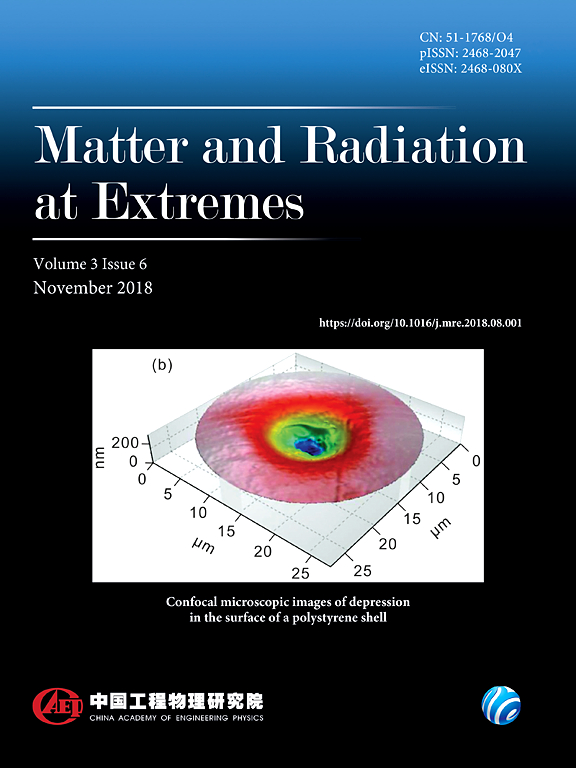Estimation of plasma parameters of X-pinch with time-resolved x-ray spectroscopy
IF 4.8
1区 物理与天体物理
Q1 PHYSICS, MULTIDISCIPLINARY
引用次数: 2
Abstract
We estimate the parameters of a Cu plasma generated by an X-pinch by comparing experimentally measured x-rays with synthetic data. A filtered absolute extreme ultraviolet diode array is used to measure time-resolved x-ray spectra with a spectral resolution of ∼1 keV in the energy range of 1–10 keV. The synthetic spectra of Cu plasmas with different electron temperatures, electron densities, and fast electron fractions are calculated using the FLYCHK code. For quantitative comparison with the measured spectrum, two x-ray power ratios with three different spectral ranges are calculated. We observe three x-ray bursts in X-pinch experiments with two Cu wires conducted on the SNU X-pinch at a current rise rate of ∼0.2 kA/ns. Analysis of the spectra reveals that the first burst comprises x-rays emitted by hot spots and electron beams, with characteristics similar to those observed in other X-pinches. The second and third bursts are both generated by long-lived electron beams formed after the neck structure has been completely depleted. In the second burst, the formation of the electron beam is accompanied by an increase in the electron density of the background plasma. Therefore, the long-lived electron beams generate the additional strong x-ray bursts while maintaining a plasma channel in the central region of the X-pinch. Moreover, they emit many hard x-rays (HXRs), enabling the SNU X-pinch to be used as an HXR source. This study confirms that the generation of long-lived electron beams is crucial to the dynamics of X-pinches and the generation of strong HXRs.用时间分辨x射线光谱学估计x-捏缩等离子体参数
通过比较实验测量的x射线和合成数据,我们估计了由X-pinch产生的Cu等离子体的参数。在1 - 10 keV的能量范围内,使用滤波绝对极紫外二极管阵列测量光谱分辨率为1 keV的时间分辨x射线光谱。利用FLYCHK程序计算了铜等离子体在不同电子温度、电子密度和快速电子分数下的合成光谱。为了与实测光谱进行定量比较,计算了三个不同光谱范围的两个x射线功率比。在SNU X-pinch实验中,我们观察到在电流上升速率为~ 0.2 kA/ns的情况下,用两根铜线进行的X-pinch实验中出现了三次x- burst。对光谱的分析表明,第一次爆发由热点和电子束发出的x射线组成,其特征与在其他x射线夹击中观察到的特征相似。第二次和第三次爆发都是由颈部结构完全耗尽后形成的长寿命电子束产生的。在第二次爆发中,电子束的形成伴随着背景等离子体电子密度的增加。因此,长寿命的电子束产生额外的强x射线爆发,同时在X-pinch的中心区域保持等离子体通道。此外,它们发出许多硬x射线(HXRs),使首尔大学的X-pinch可以用作HXR源。这项研究证实,长寿命电子束的产生对x -夹紧动力学和强hxr的产生至关重要。
本文章由计算机程序翻译,如有差异,请以英文原文为准。
求助全文
约1分钟内获得全文
求助全文
来源期刊

Matter and Radiation at Extremes
Physics and Astronomy-Atomic and Molecular Physics, and Optics
CiteScore
8.60
自引率
9.80%
发文量
160
审稿时长
15 weeks
期刊介绍:
Matter and Radiation at Extremes (MRE), is committed to the publication of original and impactful research and review papers that address extreme states of matter and radiation, and the associated science and technology that are employed to produce and diagnose these conditions in the laboratory. Drivers, targets and diagnostics are included along with related numerical simulation and computational methods. It aims to provide a peer-reviewed platform for the international physics community and promote worldwide dissemination of the latest and impactful research in related fields.
 求助内容:
求助内容: 应助结果提醒方式:
应助结果提醒方式:


